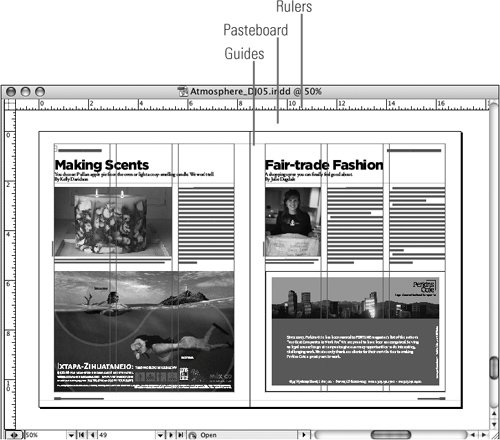Section 11. Understanding the Document Window
#11. Understanding the Document WindowThe document window is the space you work within for each InDesign document. The document window mimics an actual paste-up board with a blank area surrounding pages called the pasteboard and layout aids such as rulers, guides, and grids. Within each document window, you can control the view scale, the quality of the display, and which layout aids are showing. Most of the time, the document window displays the page or spread you are currently working on. Since it may be helpful to see different pages of a document at the same time (or different view scales), you can open multiple windows for the same open document. Reviewing the Document WindowTake a look at a standard document window (Figure 11a).
Figure 11a. The document window provides a work space similar to a traditional paste-up board.
Navigating DocumentsThe lower-left corner of the document window provides convenient controls for displaying file information and navigating documents (Figure 11b).
Figure 11b. The lower-left corner contains controls for changing the view percent and selecting pages to display.
If you are working on a document and want to see different view of itfor example, to view the first and last page at the same time or view the same page at 50 percent and 300 percentyou can open another window for the document. Simply choose Window > Arrange > New Window. Once you have multiple windows open, whether of a single document or multiple documents, you create a management issue. The bottom of the Window menu lists all the open document windows so you can choose one to display. Commands in the Window > Arrange submenu also help you manage document windows:
|
EAN: 2147483647
Pages: 142
- Chapter V Consumer Complaint Behavior in the Online Environment
- Chapter VII Objective and Perceived Complexity and Their Impacts on Internet Communication
- Chapter VIII Personalization Systems and Their Deployment as Web Site Interface Design Decisions
- Chapter X Converting Browsers to Buyers: Key Considerations in Designing Business-to-Consumer Web Sites
- Chapter XVIII Web Systems Design, Litigation, and Online Consumer Behavior